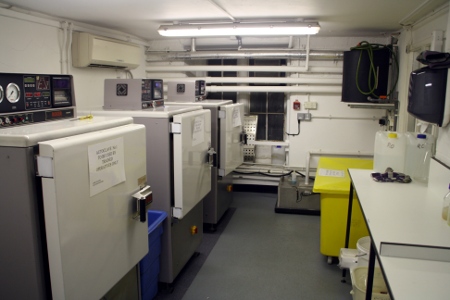Team:Cambridge/Safety
From 2011.igem.org
Please use this page to answer the safety questions posed on the safety page. ==TO DO== get updated slides from barbara - up date biosafety group paragraph with most recent names, link to code of practice.
Safety is of utmost importance during projects involving synthetic biology. Not only must the welfare of scientist and non-scientific staff within the department be considered, but also that of the wider community. It is therefore important that safety procedures are in place to minimise the risk of harm to both employees and the wider community.
This has been implemented in our lab in many ways. We took care that everyone in the team was fully aware of all the safety protocols by attending a presentation given by our lab safety officer, Barbara Landamore, and reading the Department's Code of Practice for working with genetically modified (GM) organisms before being granted GM worker status.
Contents |
The Cambridge Biosafety Group
The biological safety officer for our department is Dr Ed Tanner. An interdepartmental team, the Biosafety Group has reviewed our project brief and has passed our nominations for all members of the team to be able to work with [http://en.wikipedia.org/wiki/Biosafety_level Biosafety level one] organisms in the Plant Sciences department, which is itself an approved containment level one facility. We have thus been cleared to work with bacteria that have been classified as being "unlikely to cause human disease". However, before carrying out any work with GM bacteria, the relevant risk assessment forms must be submitted to the Head of Group within the Department for approval.
Containment
Genetically modified material must not be allowed to leave the laboratory. While the likelihood of the strains of bacteria with which we will be working surviving in the wild is low, the environmental impact of such an event could be severe, and thus every reasonable precaution must be taken to prevent such an occurrence.
During the competition we shall only be working with the least severe containment level bacteria, Containment Level 1, meaning the bacteria with which we work are classified as being "unlikely to cause human disease". This means that work can be carried out on open bench tops, but gloves and facial protections must be worn.
On a more practical level, all items which have come into contact with hazardous material must be autoclaved before disposal, and lab-coats must not leave the laboratory. Gloves must be worn during experiments, both to protect the worker and to reduce the risk of contamination.
Waste Disposal
Disposing of equipment used for experimental purposes is a significant challenge, and detailed procedures are in place within the department in order to ensure the safe disposal of all equipment, or it's recycling where possible.
TODO: add flow chart of waste disposal. For reasons best know to the plansci department webmasters it's not available externally (i.e. check that it's OK for it to go on an external site.)
Autoclave
All reasonable measures must be taken to prevent the release of biological material from the department, and so all biological matter must be autoclaved before disposal.
Glasses for autoclaving should be:
- Only partially filled: the solution will boil during autoclaving and hence expand
- Lidded (loosely) - gas must be able to escape (to prevent explosion)
- Labelled 'iGEM' so any problems can be reported back to us
- Left on the table to the right (see picture)
- Collected from the autoclaving room
Other equipment, e.g. petri dishes, should be bagged, labelled and placed in the yellow box to the right (see picture). If the items are sharp (and hence could penetrate the autoclave bags, presenting a hazard to autoclave technicians) then they should be placed in a secure closed container before being bagged.
Items which are unsuitably prepared for autoclaving (e.g. loose pipette tips in bags) wil be returned, and will not be autoclaved until they are prepared appropriately for the procedure.
 "
"


